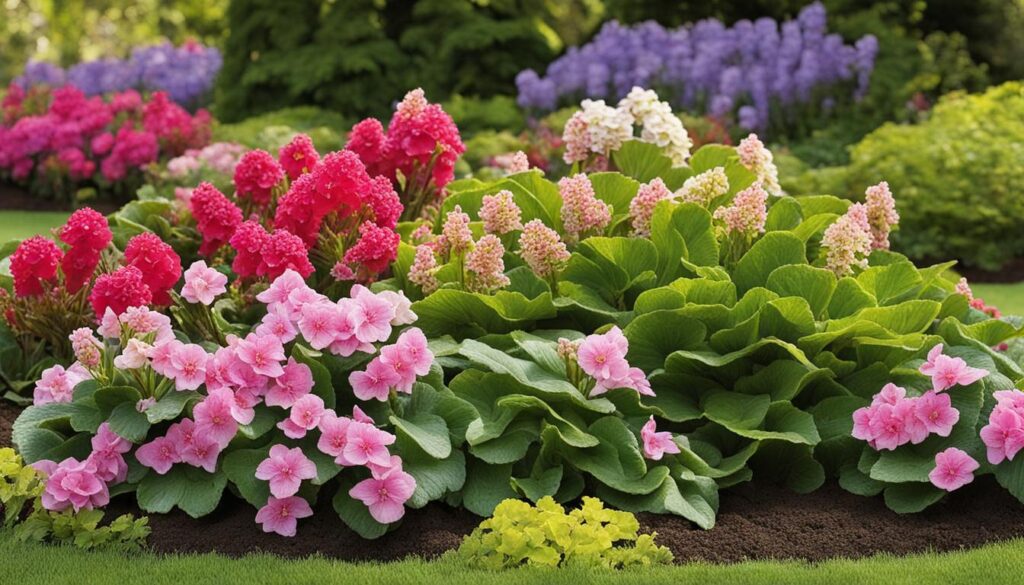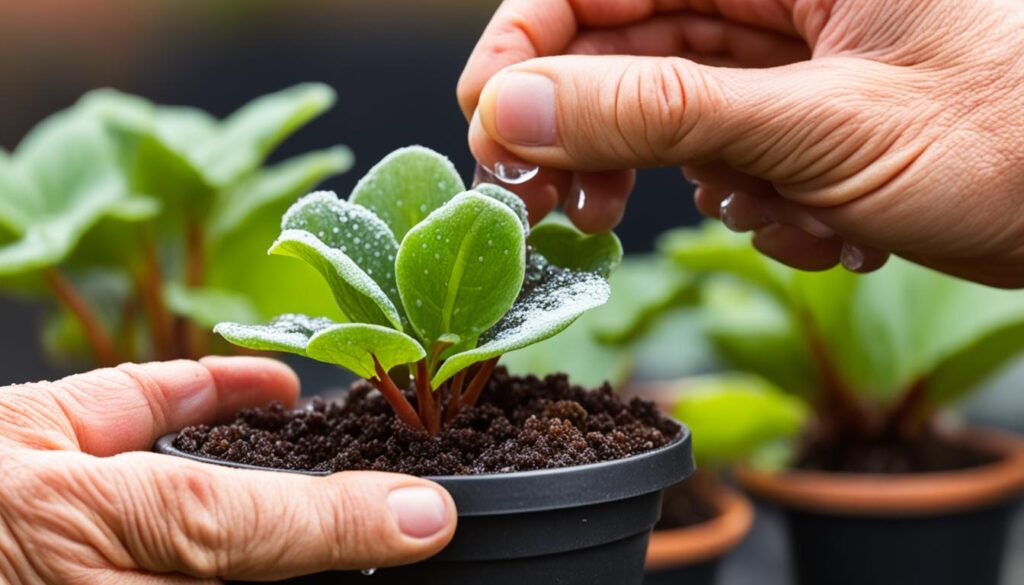
How To Grow Bergenias In The UK
Bergenias are tough, hardy, and versatile evergreen perennials that can thrive in a variety of garden conditions in the UK. They can be grown in both sunny and shady areas and can tolerate different soil types, including dry conditions. Bergenias form low, slow-spreading clumps of large, glossy green leaves that often take on reddish hues in winter. They produce clusters of pink, red, or white bell-like flowers in late winter and spring, which are valuable sources of food for bees. With their resilience and adaptability, bergenias make for an excellent choice for UK gardens.
Key Takeaways:
- Bergenias are tough, hardy, and versatile evergreen perennials.
- They can be grown in both sunny and shady areas and tolerate different soil types.
- Bergenias form low, slow-spreading clumps of large, glossy green leaves.
- They produce clusters of pink, red, or white bell-like flowers in late winter and spring.
- Bergenias are valuable sources of food for bees and can enhance the beauty of UK gardens.
Choosing the Right Bergenias
When it comes to selecting bergenias for your garden, there are a few key considerations to keep in mind. Bergenias offer a wide range of cultivars, each with its own unique characteristics, allowing you to create a stunning and diverse display in your outdoor space.
Leaf Colors: One of the standout features of bergenias is their beautiful foliage, which can range from vibrant greens to bold reds, burgundy, or bronze hues. These leaf colors offer year-round interest, with many cultivars displaying stunning autumn and winter colors.
Flower Colors: Bergenias also provide an array of flower colors to choose from. Their bell-like flowers can vary from vibrant magenta to soft blush tones, adding a touch of elegance to your garden. Additionally, the stout flower stems come in striking shades of red or purple, further enhancing their visual appeal.
Flowering Time: Most bergenias typically flower in the spring, creating a burst of color when many other plants are just starting to bloom. However, there are also cultivars that begin flowering in late winter, providing early color and attracting important pollinators like bees to your garden.
Plant Size: Bergenias generally form low-growing leafy clumps, reaching around 30cm in height. They slowly spread to about 60cm wide, creating a compact and attractive ground cover. However, there are smaller and larger cultivars available, allowing you to choose the perfect size for your specific garden setting and preferences.
By considering these factors, you can select the perfect bergenias to complement your garden design and create a visually captivating display. Whether you’re looking for vibrant leaf colors, stunning flower hues, or a specific plant size, there is a bergenias cultivar that will meet your needs.
Bergenias Cultivar Comparison
| Cultivar | Leaf Color | Flower Color | Flowering Time | Plant Size |
|---|---|---|---|---|
| Cultivar 1 | Rich Green | Bright Magenta | Spring | 30cm x 60cm |
| Cultivar 2 | Bold Red | Soft Blush | Late Winter | 30cm x 60cm |
| Cultivar 3 | Burgundy | Deep Purple | Spring | 40cm x 80cm |
| Cultivar 4 | Bronze | Light Pink | Spring | 20cm x 40cm |
This table highlights some popular bergenias cultivars, showcasing the variations in leaf color, flower color, flowering time, and plant size. Use this as a guide to help you make an informed choice and create a beautiful bergenias display that suits your garden’s unique aesthetic.
Planting and Care Tips for Bergenias
To ensure the successful growth of bergenias in your garden, it’s important to follow proper planting and care techniques. Here’s a guide to help you get started:
When to Plant Bergenias
Bergenias are best planted in early autumn, allowing them to establish themselves before their flowering season in late winter to spring. However, they can also be planted at other times of the year, as long as the ground is not frozen or waterlogged in winter or parched in summer.
Where to Plant Bergenias
Bergenias are adaptable plants that can thrive in both sunny and partially shaded areas. They prefer well-drained soil that contains organic matter. However, they can also tolerate poor soil conditions.
How to Plant Bergenias
When planting bergenias, dig a hole slightly larger than the root ball and place the plant in the hole, ensuring that the crown is at ground level. Backfill the hole with soil and gently firm it around the plant. Water thoroughly after planting to remove any air pockets.
Watering Bergenias
After planting, bergenias should be watered regularly, especially during dry spells. Ensure the soil remains moist, but not waterlogged, as excessive moisture can lead to root rot. Avoid overhead watering to prevent disease.
Mulching Bergenias
In spring, apply a thick layer of organic mulch around the base of bergenias. This will help retain moisture, suppress weed growth, and regulate soil temperature. Be careful not to pile the mulch against the base of the plant to prevent rot.
Feeding Bergenias
Bergenias do not require regular feeding. They can obtain nutrients from the organic matter present in the soil. However, if the plants appear weak or show signs of nutrient deficiency, you can apply a balanced organic fertilizer in early spring.
Overwintering Bergenias
Bergenias are hardy plants that can withstand cold temperatures. Their evergreen foliage adds rich color and interest to the garden during winter. No special overwintering care is required, but you can remove any damaged leaves in early spring to promote new growth.
Caring for Older Bergenias
After four or five years, older bergenias may need division to revitalize the clumps and promote new growth. Dig up the clump and carefully separate the rhizomes, ensuring each section has one or more leaf rosettes. Replant the divisions in the garden or in pots with compost.
Regularly remove faded flower stems and damaged leaves to keep bergenias looking their best. This will also help prevent the spread of diseases and maintain the overall health of the plants.

Propagating Bergenias
If you want to expand your collection of bergenias or share these beautiful plants with other gardening enthusiasts, you’ll be pleased to know that propagating bergenias is relatively straightforward. There are two common methods for propagating bergenias: division and seed propagation.
Division
Division is the quickest and most reliable way to obtain new bergenias. It is best done in spring or autumn when the plant is not actively flowering. Follow these steps to successfully propagate bergenias through division:
- Dig up the clump of bergenias, being careful not to damage the rhizomes (underground stems).
- Discard the old, woody center of the clump.
- Divide the remaining rhizomes into several sections, ensuring that each section has one or more leaf rosettes.
- Replant the divided sections in the garden or in pots filled with compost, making sure to plant them at the same depth as they were previously.
Division allows you to create multiple bergenia plants from a single clump, and the divided sections will establish themselves quickly, giving you more plants to enjoy. It’s also an excellent opportunity to rejuvenate older bergenias and ensure their continued growth and vigor.
Seed Propagation
While division is the preferred method for propagating bergenias, some gardeners enjoy the process of growing plants from seeds. Here’s how you can propagate bergenias from seed:
- Collect ripe bergenia seeds after the flowers have faded and the seed pods have dried on the plant.
- Place the seeds in a plastic bag and store them in the fridge for a couple of weeks. This period of cold stratification helps break dormancy and enhances germination.
- Sow the seeds either indoors in seed trays or directly into the garden soil in spring when the danger of frost has passed.
- Cover the seeds lightly with soil, water gently, and keep the soil consistently moist until germination occurs.
- Once the seedlings have developed true leaves, carefully transplant them into individual pots or directly into the garden, spacing them according to the desired clump size.
It’s important to note that propagating bergenias from seed can be a slower and less predictable method compared to division. However, it can be an exciting way to introduce new varieties to your garden and experiment with different colors and characteristics.
Remember to be patient when propagating bergenias, as they may take some time to establish and reach maturity. With proper care and attention, you can expand your bergenia collection and share the beauty of these resilient plants with others.

Conclusion
Growing bergenias in the UK is a rewarding experience, thanks to their hardy nature and versatility. By choosing the right bergenias for your garden, providing optimal planting conditions, and maintaining proper care, you can enjoy these beautiful evergreen perennials year-round.
Bergenias add color and interest to the garden with their stunning foliage and early spring flowers, attracting bees and pollinators. With their ability to tolerate different soil types, sun or shade, and dry conditions, bergenias are ideal plants for UK gardens.
By following the tips and techniques discussed in this guide, you can successfully grow bergenias and enhance the beauty of your garden. So why wait? Get started on your bergenias journey and enjoy the rewards of growing these hardy plants in your UK garden.
FAQ
When is the best time to plant bergenias?
Bergenias are best planted in early autumn to allow them to establish before their flowering season in late winter to spring. They can also be planted at other times of the year as long as the ground is not frozen or waterlogged in winter or parched in summer.
Can bergenias tolerate different soil types?
Yes, bergenias are adaptable plants that can tolerate different soil types, including dry conditions. However, they prefer well-drained soil that contains organic matter.
Do bergenias require feeding?
No, bergenias do not require feeding. They can thrive without additional fertilizers.
How do I care for older bergenias?
Older bergenias may need division after four or five years to revitalize the clumps and promote new growth. Regular removal of damaged leaves and faded flower stems will keep the plants looking their best.
Can bergenias be propagated from seed?
Yes, bergenias can be propagated from seed. However, it requires a period of cold stratification before sowing. Division is a quicker and more reliable method to obtain new bergenias.